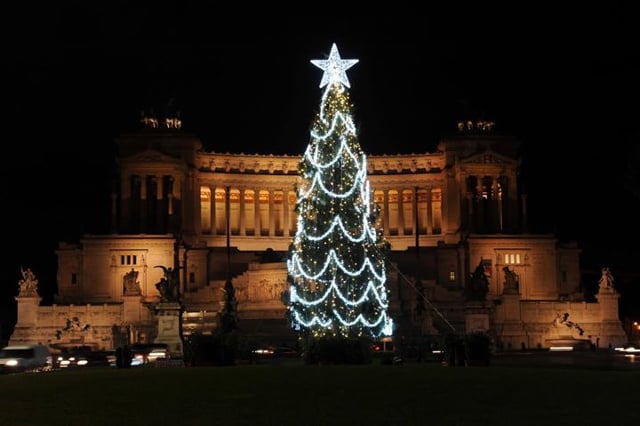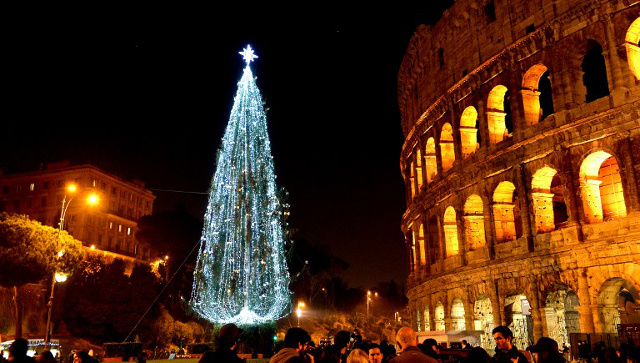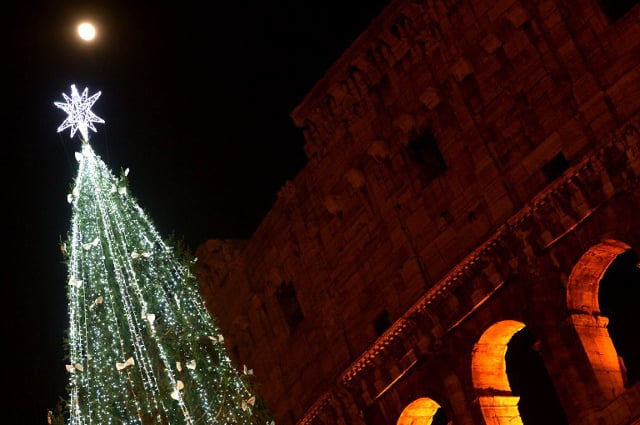1. Via del Corso
Rome's main shopping street gets decked out in lights for the festive season. Walk down the 1.5km street, making sure to check out the elaborate displays by some of the designer shops on the way, and you'll end up at Piazza Venezia – where you can see the tree which was named “the world's ugliest – but has now had a sparkly makeover.

The glammed-up tree. Photo: Comune di Roma
2. Monti
Wander down the streets of this district, tucked away behind the Colosseum, for some of the best lights in the city. It's a great place for Christmas shopping and there are plenty of bars and restaurants for you to warm up in. Vintage lovers should check out Mercato Monti, which doubles in size throughout December.
The recently-restored steps are adorned with a nativity scene and huge tree, adding a nice festive feel to this spot in the heart of the shopping district. You should be able to find chestnut sellers in Piazza di Spagna too, so it's a treat for all the senses – and the perfect place for people-watching.
4. Piazza Navona
Rome's biggest Christmas market is back, with stalls selling food, gifts and decorations, plus a carousel and games. Babbo Natale himself is even set to make an appearance!
A guaranteed way to get in the Christmas spirit is checking out this annual display of nativity scenes from around the world. Expect creations of all sizes, materials and themes, with everything from complex designs depicting an entire village to contributions by schoolchildren. For kids, there's a special workshop on making nativity figures – out of pasta.
6. Colosseum
Whether it's the first or 1001st time you've seen it, the imposing Colosseum never fails to impress. This is the first Christmas since its restoration earlier this year, so it will look even better than usual, especially with the enormous tree.

Photo: Tiziana Fabi/AFP
7. Piazza San Pietro
It almost goes without saying that the Vatican is the place to be for the biggest holiday in the Catholic Church. Visit in the evening to see the tree lit up and the life-size nativity: baby Jesus isn't there yet, but the Pope will add him on Christmas Eve. If you're in Rome on the big day itself, you can even go to the Christmas Eve mass led by Pope Francis. And this year, the cross and some debris from the Basilica di San Benedetto in Norcia, destroyed by the earthquakes earlier this year, are also on display.
8. Castel Sant'Angelo
It's unlikely we'll get a white Christmas here in Rome, but you can still go skating! There are several indoor rinks dotted across the city, but we recommend the outdoor one at Castel Sant'Angelo for the best holiday feel. The former prison is an impressive backdrop, and the bridge leading to it looks spectacular when lit up at night. The rink is open every day until midnight.
9. Trastevere
Tourist trap it might be, but at winter this district feels less crowded and much more cosy. Get a hot chocolate or whipped cream-topped liquor shot from Cioccolata e vino, try the pastries at Checco, or visit any one of the many pubs, bars and restaurants that line the streets. The Santa Maria di Trastevere church has special services and carol concerts throughout the advent season, and the winding streets are adorned with lights.
10. Gianicolo Hill
Walking up the Gianicolo Hill gives you one of the best views of the city whatever the season, but it's surely at its most awe-inspiring at dusk in winter, when you can look out over Rome in all its sparkly Christmas glory – the city looks like a beautiful nativity scene.



 Please whitelist us to continue reading.
Please whitelist us to continue reading.
Member comments